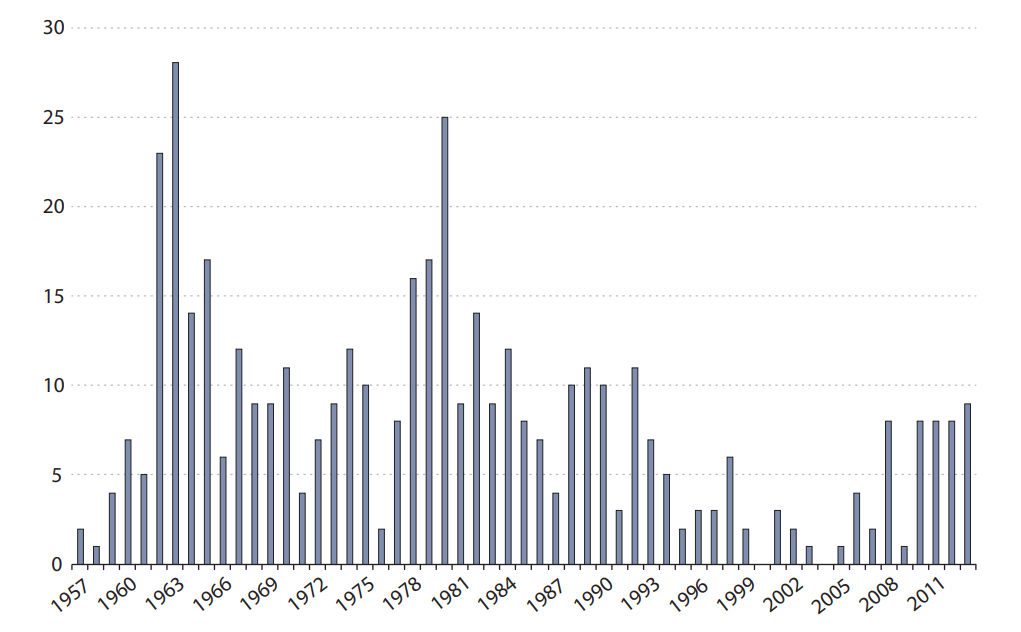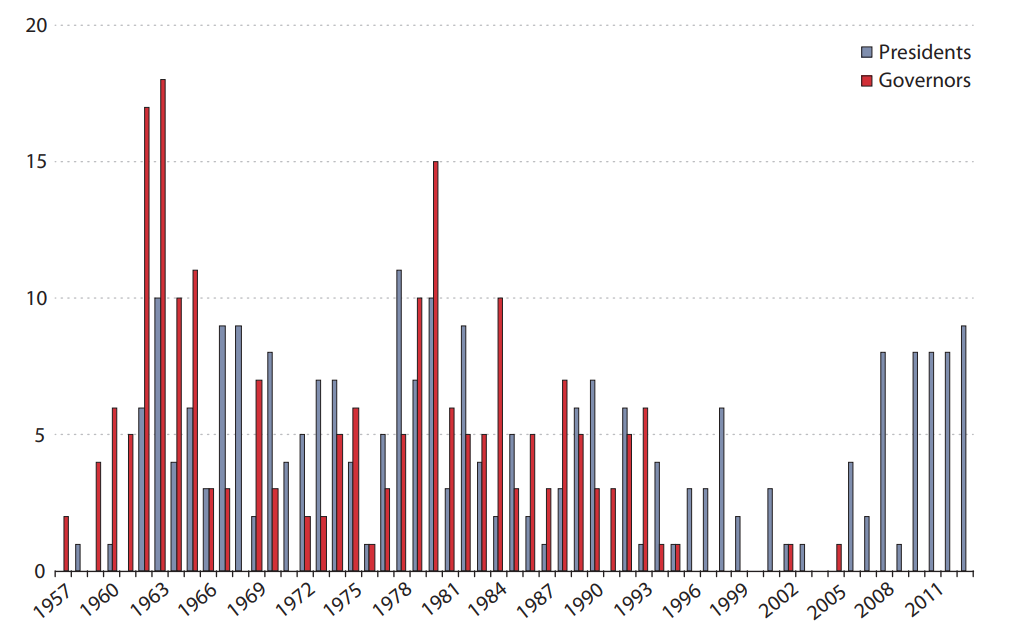A History of FOMC Dissents
This article was last updated in March 2024 with the latest Excel file of dissents.
The number of dissenting votes on Federal Open Market Committee (FOMC) policy decisions averaged nearly one per meeting between 2008 and 2013. While the frequency of dissents was not unusual based on historical comparisons, it was unusual that Federal Reserve bank presidents accounted for all of the dissents in those years, according to an article in the Federal Reserve Bank of St. Louis Review: Making Sense of Dissents: A History of FOMC Dissents.
Daniel Thornton and David Wheelock, both with the St. Louis Fed, examined dissents on FOMC monetary policy votes since 1936, when the FOMC first met in its current form. The FOMC has 12 voting members—the seven members of the Board of Governors and five Federal Reserve bank presidents. The New York Fed president is a permanent voting member. The remaining 11 Reserve bank presidents serve as voting members on a rotating basis.
View a record of FOMC dissents from 1936-present
Thornton and Wheelock's article presents a record of dissents on FOMC monetary policy votes from 1936 through 2013. The Excel file below extends their dataset and is updated regularly. In addition to showing the total number of dissents at each meeting, the file breaks down the number by FOMC member type (governors and presidents) and whether the dissents were in favor of easier policy, in favor of tighter policy or for other reasons.
- Download data: Excel file, updated March 22, 2024
FOMC meetings occurred more often after 1955 (between 10 and 19 meetings per year), meaning that members had more opportunities to dissent. In the early 1980s, the FOMC began having eight scheduled meetings per year. Focusing on the period 1957-2013, the authors found that only 6% (449) of the votes cast for FOMC policy directives were dissents. Before 1957, 13 dissents on FOMC policy votes occurred. All of them were by governors and during the period 1938-40.
As shown in the first figure below, the frequency varied considerably, ranging from zero dissents in 2000 and 2004 to 28 in 1963. The frequency was particularly high during the periods 1962-65 and 1978-80.
Numbers of Dissents by Year (1957-2013)

SOURCE: Thornton and Wheelock
The following figure breaks down the number of dissents by FOMC member type. Over the period 1957-2013, Reserve bank presidents dissented 241 times, and Fed governors dissented 208 times. While the number of dissents by governors exceeded the number of dissents by presidents in many years, Thornton and Wheelock noted that presidents have accounted for all but four (72 of 76) dissents between 1994 and 2013.
Dissents by Year and Member Type (1957-2013)

SOURCE: Thornton and Wheelock
The authors examined whether governors and presidents differed in their tendency to dissent in favor of “tighter” or “easier” policies. Including the 13 dissents before 1957 brings the total number of dissents to 462 over the period 1936-2013. Of those, the authors classified 249 as favoring a tighter policy, 160 as favoring an easier policy and the remaining 53 as neither.For the other 53 dissents, either no explanation was provided in the official records or the dissents were based on considerations other than the current stance of monetary policy.
Summary of Findings
Thornton and Wheelock found that Reserve bank presidents more often dissented in favor of tighter policy than easier policy, whereas Fed governors’ dissents were more often in favor of easier policy.
- Presidents dissented 35 times in favor of an easier policy and 180 times in favor of a tighter policy.
- In contrast, 125 dissents by governors were for easier policy and 69 were for tighter policy.
- Presidents accounted for 22% of all dissents for easier policy, while governors accounted for 78%.
- Of the dissents for tighter policy, presidents accounted for 72% and governors for the remaining 28%.
The article provides further analysis on the history of FOMC dissents and reasons for changes in the frequency over time. It examines:
- The number of dissents by every FOMC member who has cast a dissenting policy vote.
- The number and frequency of dissents under the various Fed chairmen.
- The relationship between the dissent rate and inflation/unemployment.
- Explanations for dissents given in official FOMC records.
Notes
- Before 1957, 13 dissents on FOMC policy votes occurred. All of them were by governors and during the period 1938-40.
- For the other 53 dissents, either no explanation was provided in the official records or the dissents were based on considerations other than the current stance of monetary policy.
This blog offers commentary, analysis and data from our economists and experts. Views expressed are not necessarily those of the St. Louis Fed or Federal Reserve System.
Email Us
All other blog-related questions


